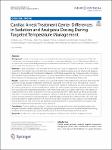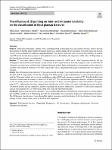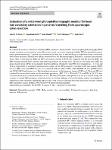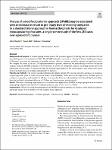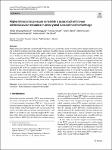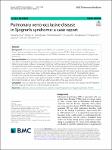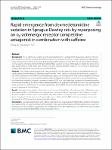Search
Author
- Osman, Ahmed I. (5)
- Daqing, Ma (3)
- Jorgensen, Ed (3)
- Li, Yan (3)
- next >
Subject
- kinh tế (26)
- Economics (12)
- programming (10)
- XRD (10)
- next >
Date issued
- 2020 - 2025 (2129)
- 2010 - 2019 (129)
- 2000 - 2009 (9)
- 1999 - 1999 (1)
Has File(s)
Search Results
Health-related quality of life after surviving acute respiratory distress syndrome has come into focus in recent years, especially during the coronavirus disease 2019 pandemic. |
Sedation and analgesia are recommended during targeted temperature management (TTM) after cardiac arrest, but there are few data to provide guidance on dosing to bedside clinicians. We evaluated differences in patient-level sedation and analgesia dosing in an international multicenter TTM trial to better characterize current practice and clinically important outcomes. |
Tibial plateau fractures continue to be a challenging task in clinical practice and current outcomes seem to provide the potential for further improvement. Especially presurgical understanding of the orientation of fracture lines and fracture severity is an essential key to sufficient surgical treatment. The object of this study was to evaluate the reliability of modern axial CT-based classification systems for tibial plateau fractures. In addition, the diagnostic-added value of 3D printing on the classification systems was investigated. |
To compare the severity of pulmonary embolism (PE) and the long-term complications between patients with and without COVID-19, and to investigate whether the tools for risk stratification of death are valid in this population. |
To evaluate the accuracy of heart rate variability (HRV) parameters obtained with a wrist-worn photoplethysmography (PPG) monitor in patients recovering from minimally invasive colon resection to investigate whether PPG has potential in postoperative patient monitoring. 31 patients were monitored for three days or until discharge or reoperation using a wrist-worn PPG monitor (PulseOn, Finland) with a Holter monitor (Faros 360, Bittium Biosignals, Finland) as a reference measurement device. |
A tendon-sparing modification of the posterior approach to the hip joint was introduced in the specialist hip unit at our institution in 2016. The SPAIRE technique—acronym for “Saving Piriformis And Internus, Repair of Externus” preserves the insertions of gemellus inferior, obturator internus, gemellus superior and piriformis intact. We compare the results of the first 285 hip hemiarthroplasty patients, unselected but preferentially treated by our hip unit surgeons using the SPAIRE technique, with 567 patients treated by all orthopaedic surgeons (including the hip unit) in the department over the same 3.5 year period using the standard lateral approach. We report length of stay, return to pre-injury level of mobility, place of residence and mortality at 120 days. |
Higher intracranial pressure variability (ICPV) has been associated with a more favorable cerebral energy metabolism, lower rate of delayed ischemic neurologic deficits, and more favorable outcome in aneurysmal subarachnoid hemorrhage (aSAH). We have hypothesized that higher ICPV partly reflects more compliant and active cerebral vessels. In this study, the aim was to further test this by investigating if higher ICPV was associated with lower cerebrovascular resistance (CVR) and higher cerebral blood flow (CBF) after aSAH. |
Pulmonary arterial hypertension (PAH) associated with connective tissue disease (CTD) belongs to Group 1 pulmonary hypertension. Pulmonary veno-occlusive disease (PVOD), which is characterized by venous system aberrations, has been previously reported in CTD-PAH; however, it has rarely been observed in Sjogren’s syndrome (SS). |
Disseminated cryptococcal infection is especially prone to occur in immunosuppressed hosts. We herein report the case of an immunosuppressed girl with disseminated cryptococcal infection in whom pulmonary cryptococcosis (PC) presented as diffuse cavitary pulmonary nodules, a finding which has rarely been reported. |
The α2 adrenergic receptor agonist dexmedetomidine is an important intravenous sedative with analgesic properties. Currently available dexmedetomidine reversal agents, like the α2-receptor antagonist atipamezole, cause serious adverse effects at the large dosages required for effective reversal; they are not used clinically. Without reversal agents, emergence times from dexmedetomidine sedation are slow. In this study we tested the ability of low-dose atipamezole, in combination with caffeine, to reverse dexmedetomidine sedation. The low dose of atipamezole employed should not be associated with unwanted effects. |


